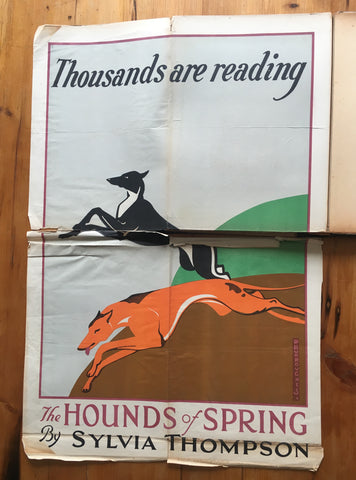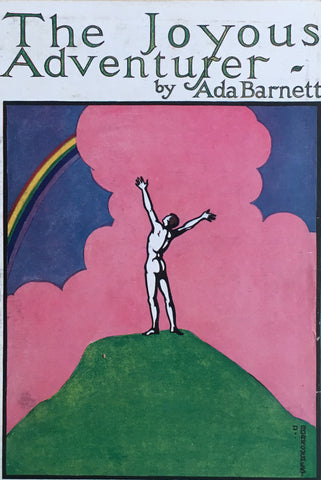Dorothy Mary Burroughes (1883-1963)
Commercial artist, illustrator and author
Like so many female commercial artists and illustrators of her generation, Dorothy Burroughes is not well-known today. I first became familiar with her posters while researching London Transport Museum’s Poster Girls exhibition, and one of her Underground designs features in the accompanying publication. But it wasn’t until I recently came across a scrap book of Burroughes’ work, almost certainly put together by the artist herself, that I began to realise the full extent of her talent. An Associate of both the Royal Society of British Artists and the Society of Women Artists, her varied and highly-regarded output included children’s books (which she wrote and illustrated), posters, book covers, lino-cuts, and illustrations for a wide range of magazines and publications. This blog is an initial attempt to piece together Burroughes’ extraordinary life and achievements.

Dorothy was born into a wealthy London family. Her father, James Burroughes, was the proprietor of Burroughes & Watts, Britain’s leading manufacturer of billiard tables and accessories. The family lived in a grand house on Portland Place, and when James died in 1912 he left over £90,000 together with a thriving business that enjoyed royal patronage. I haven’t been able to ascertain exactly when Dorothy undertook her formal training as an artist, but it seems that she studied at the Slade and later at Heatherley’s School of Fine Art in the years leading up to the First World War.

Underground poster 1920
Her big break as a commercial artist came in 1920 with a commission from London Underground for a poster promoting trips to the Zoo at Regents Park. The resulting design features a group of Langur monkeys, drawn in a sympathetic and Japanese-woodcut inspired style which was to become synonymous with Burroughes’ later animal studies. It was an immediate hit with the travelling public and a second commission, also for the Zoo, followed in 1922. The new design, known as ‘the monkey poster’, was even more popular, becoming London Underground’s most requested poster to date with spare copies sold via the Advertising Department to meet demand.

Underground poster 1922
Contemporary reviewers were equally enthusiastic. Commercial Art declared that ‘Miss Burroughes is a magician, who by the simple, though difficult device, of elimination, and my means of her unerring colour-sense, can transform an ugly little brute and a sad little captive into an aristocrat of the Simian tribe’. The illustrator and critic, Percy Bradshaw, wrote that ‘Burroughes is a born poster artist, who though she had derived a great deal of inspiration from the Japanese, has added her own delightful grace and humour’.

'The Black Panther', c.1923
Similar praise was lavished on her first solo show, held at the Dorian Leigh Gallery, South Kensington, in 1923. The exhibited works included many of her exotic animal paintings, which were now appearing in weekly magazines such as The Sketch and Illustrated London News. A review published in The Advertising World was typical of the press response: ‘Of quite remarkable merit was ‘The Black Panther’ with its accomplished draughtsmanship and showing the crouching animal with wonderful fidelity. The drawing is instinct with life, a study in black and green. It would be a wonderful success on the hoardings’. Commercial Art agreed, adding that Burroughes was now one of the country’s leading animal artists alongside Cecil Aldin and Harry Rountree.

For Dorothy, however, drawing animals from life at London Zoo was a painful experience. In an interview with Drawing & Design (1923) she confessed that it was heart breaking to look into the eyes of the caged lions, imprisoned in their enclosures. Instead, she had tried to paint a wolf, but found that its’ eyes, too, ‘were too full of dreams and pain and captivity to bear looking at, and to attempt to draw them seemed sacrilege’. Even so, her skill at capturing the character and dignity of animal subjects was widely admired and in 1925 she was made a Fellow of the Zoological Society in recognition of her talent.

Drawing & Design, 1923
By now Burroughes was in her early forties, although she looked much younger leading several reviewers to presume she was at the start of her career. In describing her appearance at an exhibition in 1923, one newspaper commented that Burroughes seemed ‘almost boyish in her wide velour hat and a navy frock fashioned on the famous uniform of the Blue Coat School’. She was certainly unconventional and from about 1913 was living with her partner Vere Hutchinson (1891-1932), firstly in unfurnished rooms off the Harrow Road and later in a large house in Maida Vale.

Book jacket design, 1928
Hutchinson was a moderately successful novelist, and the daughter of a general, who published five books during the 1920s. For most of her relationship with Burroughes, she suffered from debilitating illnesses bought on by a virus that was ultimately to lead to her untimely death at 41. Hutchinson continued writing to the end of her life, with Burroughes designing several of the book covers. In fact, Dorothy was now illustrating books and dust jackets for a wide range of authors, including Ada Bennett, Jane Cardinal (Ethel Williamson), Sylvia Thompson, and Mary Ruth Mayhew ('Mrs Henry Head'). Her commercial work, generally, was in the ascendancy with occasional poster commissions (such as a design for the shoe retailers Lilley & Skinner, 1929) and regular magazine illustrations. She had also forged a reputation as a talented lino-cut artist, with several of her designs purchased by the Victoria & Albert Museum, and had published two illustrated books: Queer Beasts at the Zoo and Queer Birds at the Zoo (both 1927).


Lino-cuts purchased by the V&A, 1926
Despite their success, and privileged backgrounds, the couple struggled for money and rented out the upper floors of their house in Maida Vale while they lived in the basement. Somewhat bizarrely, they also supplemented their income by breeding West Highland Terriers, although their situation had improved sufficiently to enable a move to Hampstead by about 1928. Hutchinson’s health, however, continued to deteriorate and she died four years later.

Poster version of book jacket, 1928
The 1930s saw the beginning of a new phase in Burroughes’ career as a successful children’s author. Between 1930 and 1953, Dorothy wrote and illustrated over twenty children’s books, sometimes in partnership with others. A full list of her books held at the British Library can be viewed here. Burroughes continued to provide illustrations for magazines, and to sell animal paintings from her new studio at Brockley Close in Stanmore. She also found time to illustrate the monthly Burwat Billiard View – the staff journal of Burroughes & Watts – even though she was said to regret the number of elephants that had been killed to provide ivory for the billiard balls made by the family firm.

The Burwat Billiard View, Nov 1931
At the outbreak of the Second World War, Dorothy was living in Wycombe, Buckinghamshire. Her books and exhibitions became less frequent during the 1940s and she seems to have retired by about 1953 when she was 70. At the time of her death on 18 July 1963 she was living in the comfortable surroundings of Turville Heath, near Henley-on-Thames, and left over £26,000 in her will.

Book jacket, 1923
Poster Girls, at London Transport Museum, Covent Garden, runs until January 2019.



Comments on post (8)
David ross bailiff says:
Dorothy Burroughs in later years lived with my father’s sister Margaret known as Peggy at a house then called three ways Turville heath of which I visited many times when I was younger ,I also own various works of art buy dorothy Burroughs, any information I can possibly give please contact
Hilary says:
Would you be able to provide any information about the sources you used? Vere was known to her friends as Tod (interview with Budge in The People, 14/08/32). I believe their move to Hampstead in 1928 was facilitated by their wealthy friend Toupie Lowther (suggested in the same interview reported in The People).
Catherine Waugh says:
Such interesting reading. Her partner Vere Stuart Menteth Hutchinson was my great great aunt – so it was interesting reading for me – there is such little information about Vere. I love to imagine the life the would have led in the 20’s – so ahead of their time.
Kevin says:
I happenchanced upon this webpage when researching a piece that Burroughes did of my aunt (by affection) Joe Carstairs (Marion B Carstairs). It’s a beautiful linocut illustration of Aunt Joe behind one of her racing boats that she gave to my great-aunt.
Patricia Welles says:
I bought her watercolour Mandrill monkey painting in Barnes, England in the seventies and found out today that my daughter sold it at auction in the U.S. without telling me. I am broken hearted. It was worth fifty times more than she got for it and if I could find who bought it, I would buy it back Meantime, where do I buy her posters? Patricia Welles
Robin L Harman says:
I’ve just come across a signed copy of a book she wrote here at Turville Heath. She based her drawings on the farm animals here and she has signed it as a gift to my father. I run a farm cafe here and would like to create a permanent exhibition of her children’s books here. Any information about her or relatives who might have pictures of her here on the Heath would be very much appreciated. The book was Teddy the little Refugee mouse.
Peter Verney says:
Thank you for this marvellous post. Dorothy gave me a signed copy of The Little White Elephant when I was a toddler in the late 1950s. I still have it. And I thought of her when I saw real giraffes in the wild, decades later.
Simon Burroughes says:
Fascinating reading, this lady was my Dad’s Grandad’s sister. He has a couple of early books written by her and signed by her.
Leave a comment